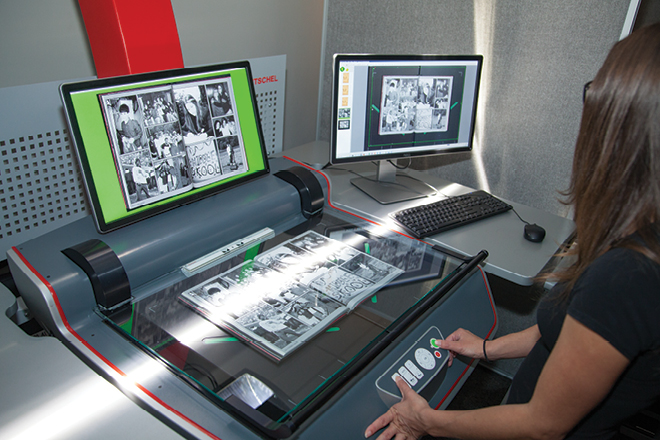Article by Donna Davis
“We are a hoarding school,” said Laurelle Sheedy McCready, associate head of school for finance and operations at The Lab School, a grades 1–12 day school with 385 students in Washington, D.C. “I’m afraid that there is no piece of paper that has ever been thrown out” — including 22-year-old phone messages written on pink duplicate paper.
The school had stashed its paper records in classrooms, file cabinets, on-campus “ holes” and external storage sites, some of them stacked to the ceiling with boxes. McCready, who had already worked with trustees to adopt a document retention and destruction policy, decided to digitize in 2015.
As with virtually every industry, schools are turning to digital records for both administrative documents and historical records. The business case is strong. Schools free up space and save money on not only but also on storage and storage retrieval costs. They can improve compliance with document retention rules, speed up retrieval and capitalize on readily accessible data. Added efficiencies translate to better customer service — whether for a student requesting a transcript or a potential donor asking to look at an old yearbook — as well as increased productivity for staff. And with proper measures, all that information can be kept safe from loss, an omnipresent threat in the case of system failure or natural disaster.
The Lab School used a hybrid approach to digitizing its 50 years of records, tackling some projects in-house and hiring a document management company for others.
For student records, the in-house approach made the most sense. Because the school educates students with learning disabilities, student records include not just transcripts but also often-voluminous psychological evaluations and individualized learning plans. “We could not farm this out because we had to have someone who understood our definition of what has to go into a transcript,” McCready said. The school hired a college student part-time, and the school registrar trained her on which items to archive. Using a copier that scanned documents to the school’s network drive and filed them in digital folders, the student spent two years scanning and indexing the records, past and present. Items like artwork and extraneous notes went to the shredder.
The time and efficiency benefits were immediate. “A request for a transcript used to take eight or nine business days because we had to determine which box it was in, have the box delivered, find the transcript, copy it and mail it out,” McCready said. “Now we can handle the request in under an hour. We do a keyword search (by name or ), up comes the digital code and we email it out.”
Then staffers took on business records — sorting through external storage units and 70 on-campus file cabinets. “With the document retention and destruction policy in hand, we knew what was considered permanent and what was not,” McCready said. Among items kept: annual reports, deeds, charts of accounts, bond documents, 990s and employment contracts.
Lab School staffers then packed up hundreds of boxes, each indexed according to its contents, for GRM, the New Jersey-based document management company that digitized its business, governance and human resources documents. Two months later the digitized documents were online and accessible — backed up on just two disks. “Nothing was missing; some things were named differently, but it was all there and legible,” said McCready.
GRM’s bill was less than $3,000, with the rest of the costs stemming from the part-time help and a week of business-staff work — for a total of about $25,000. At the same time, the school saved about $8,000 a year on off-site storage, McCready said.
Jay Crider, vice president of sales for GRM, has seen a recent increase in schools looking to digitize their records, especially in the areas of student and human resources files. Compliance pressures are a driving force. “Information not being accessible and not being protected are issues,” Crider said. “More timely turnaround is beneficial to the school as well as the requester.”
GRM and other document management companies convert physical documents in all sizes and formats as well as once-state-of-the-art archiving materials like floppy disks, and microfiches. As time passes, it becomes more difficult to find or repair the hardware needed to read those items. And in the case of microfilms and microfiches, the films are beginning to deteriorate, Crider said.
Many factors come into play when determining the cost of digitizing records, including volume, of documents, data capture and software requirements. “Return on investment is almost always there when looking at the long-term cost of managing the physical records,” Crider said. “You are not able to file requests for information quickly, the information is not secure and often not compliant, and it can be very expensive to store (physical) items for years.”
In determining costs, vendors can assess which documents schools have prioritized for digitization and develop individual proposals. They also can work with existing information systems as another money-saving option, Crider said.
Preserving 250 Years of History
Two factors led Newark Academy, in Livingston, New Jersey, to establish a digital archive of its historical material. The grades 6-12 day school with 593 students celebrates its 250th anniversary in 2024. More urgently, the faculty member who served as school archivist retired following the 2017 academic year, after 53 years at the school.
“That sort of personality-dependent approach probably isn’t the best thing for a school that is 250 years old,” said Lisa Grider, director of advancement and point person for the school’s archiving project. Neither was a do-it-yourself approach.
“The whole notion of us paying salary and benefits for an archivist did not seem appropriate for us,” she said. “We looked at possibly engaging a graduate because Rutgers has an archival librarian program, but that meant a tremendous amount of supervision.” In addition, no one at the school was qualified to evaluate the massive quantity of items, from hand-written enrollment records from the 1800s to 3-D objects, including sports uniforms and trophies.
In late 2016, Grider contacted several firms that specialize in historical and settled on Heritage Werks, based in Atlanta. The school chose a basic package of services. “It’s not inexpensive, but they had a clear understanding schools and budgets. We negotiated south of six figures but it was still a substantial investment.” The company picked up the collection in May, and work is expected to be completed in early 2018.
Digitizing the school’s historical collection means adding knowledge and access, Grider said. “I know there is great stuff in there, and retrieving it is not easy.” Now, for instance, “for a teacher who wants to look at Newark Academy in the 1800s and what was going on in the world then, it will be a living, breathing teaching tool for the school as opposed to a bunch of stuff in boxes.”
Legacy Online
When Mary Ellen Pethel joined Harpeth Hall School as a history teacher in 2007, she also took on the job of part-time archivist, helped in part by doctoral research she had already done on the 150-year-old school’s predecessors, Ward Seminary for Young Ladies and the Ward-Belmont School. Harpeth Hall, which educates nearly 700 girls in grades 5–12 in Nashville, Tennessee, had thousands of items in its archives.

“Ideally, you want to digitize everything, but it costs money,” Pethel said. “You have to prioritize.” So far, the archiving projects have cost about $10,000, she said.
In 2009, the school purchased a software package called PastPerfect Online, a web publishing tool that creates an online of items. Pethel focused on digitizing images, using standard archival practice to organize them by topic and chronology. The process is ongoing, with the help of alumnae and parent volunteers who are following the archival record system Pethel created so that items can be found both in the database or in storage.
A $250,000 grant from the Alfred P. Sloan Foundation subsidized the school’s cost of digitizing its periodicals, dropping the expense from 50 cents to 10 cents per page. Pethel sent four “huge” boxes of yearbooks, newspapers, literary and alumni magazines to Lyrasis, a partnership of libraries, museums and other cultural heritage groups that lower-cost digitization of archival materials. Lyrasis digitized the materials — about 40,000 pages in all — and placed them on its free, open-to-the-public site. The site has generated a lot of interest, with some yearbooks getting 2,000 or more views, Pethel said.
Donna Davis is a freelance writer based in Boulder, Colorado. A contributor to Net Assets since 2008, she specializes in education-related topics.
Download a PDF of the article.


.png?sfvrsn=e0147111_1)


